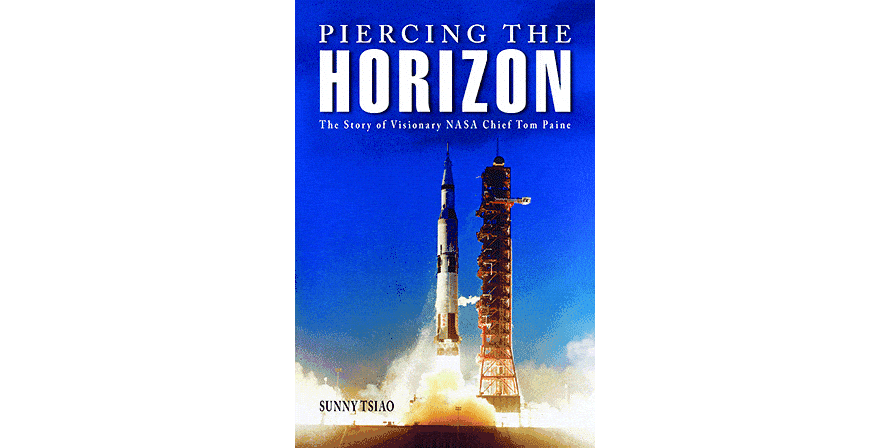Category: Nonfiction
Reviewed by: Clifford R. McMurray
Title: Piercing the Horizon: The Story of Visionary NASA Chief Tom Paine
Author: Sunny Tsiao
NSS Amazon link for this book
Format: Hardcover, Kindle
Pages: 266
Publisher: Purdue University Press
Date: October 2017
Retail Price: $29.95/$20.99
ISBN: 978-1557537911
Tom Paine was a member of the Greatest Generation. The son of a submariner, he spent World War II sinking Japanese ships from the bridge of a submarine while teenagers like Neil Armstrong and James Lovell read about such exploits in newspapers. Patriotic, nominally a Democrat but basically apolitical, trained as an engineer, a believer in the ability of industry to do great things for the country while partnered with government (not the other way around), it’s easy to imagine him as a career naval officer like his father, rather than the technocratic manager he became. His position as NASA Administrator for the first seven Apollo flights, including the first Moon landing and the crisis of Apollo 13, was almost a coincidence rather than a life goal. Yet he wound up as the spaciest of space cadets, spending his post-NASA days hanging out with the Mars Underground and designing a Martian flag.
Paine went to work for General Electric after mustering out of the Navy, and spent the postwar years rising through the ranks to management. In 1963 GE tapped him to head up their Advanced Projects Office, called TEMPO. His work on providing solutions to government problems didn’t touch on space, but brought him to the attention of John W. Macy Jr., chairman of the Civil Service Commission. Macy’s job was to connect appropriate outside talent with positions in the management of various government agencies. He offered Paine a job as Assistant Secretary of Transportation. Paine turned down that job as too political to allow much chance to do anything good, but when NASA administrator James Webb was looking for a new deputy administrator in late 1967, Macy called Paine again. Paine talked to Webb and thought he could do a good job as “Mr. Inside” technical manager while Webb continued using his consummate political skills as “Mr. Outside.” That arrangement worked well, but it didn’t last long. Just a year after Paine joined NASA, Webb announced he was stepping down. “Mr. Inside” was now the acting NASA administrator, just in time for the first crewed Apollo launch.
Gifted technical manager that he was, Paine was no politician. That Nixon didn’t replace him with a Republican appointee says something about how little importance the new administration placed in the space program. Nixon was happy with the positive public relations America’s human spaceflight program provided at home and overseas, but not happy enough to devote major resources to the program. NASA’s budget peaked before the first Moon landing; after that, it declined even more precipitously. The Space Task Group appointed by Nixon to recommend a path for NASA in the post-Apollo era presented a grandiose plan including a space shuttle and space station, Moon base and Mars landing mission, all to be done well before the end of the century. The only element of this plan Nixon was willing to approve was a space shuttle—and a scaled-down shuttle, at that.
Paine left NASA in 1970, but he had been well and truly bitten by the space bug. He continued to advocate for a more expansive government space program, as head of Reagan’s National Commission on Space, and as a member of the Augustine Committee tasked with developing an implementation plan for President Bush Sr.’s Space Exploration Initiative. Both plans were dead on arrival; the country just wasn’t interested in spending big money on space any more. Paine continued in engineering management, first back at General Electric as head of their worldwide electrical power generation business, then as CEO at Northrop Corporation, where he led that company to great success; Dun’s Business Month named it one of the five best-managed companies in America.
Paine was both a visionary and a technocrat. America was fortunate to have him as leader of NASA to manage its team of 400,000 workers for the home stretch of the Moon Race, and it’s no fault of his that his vision was out of step with what the nation wanted next. Like Wernher von Braun, who worked for him, he was cursed with a dream far greater than he could persuade America to grasp with him. But this book shows his cheerful spirit in the quest. He never stopped dreaming, and he never stopped preaching the dream.
© 2018 Clifford R. McMurray
Please use the NSS Amazon Link for all your book and other purchases. It helps NSS and does not cost you a cent! Bookmark this link for ALL your Amazon shopping!




















1 thought on “Book Review: Piercing the Horizon: The Story of Visionary NASA Chief Tom Paine”
Great review Cliff!